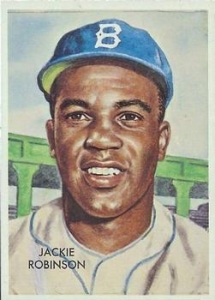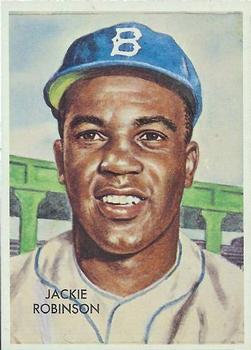October 9, 1956: Clem Labine’s extra-inning shutout, Jackie Robinson’s walk-off single force Game 7

The Brooklyn Dodgers had fallen behind in the 1956 World Series in historic fashion. In Game Five, their hitters came up empty as Yankees hurler Don Larsen threw the first World Series perfect game. Larsen’s performance put the defending world champion Dodgers’ backs to the wall, trailing in the series three games to two.
Faced with the prospect of elimination, Dodgers manager Walter Alston made an unlikely choice for a Game Six starter in Clem Labine. Labine had pitched in a franchise-record 62 games during the regular season, going 10-6 with a 3.35 ERA; however only three of his 62 appearances had been starts. The veteran right-hander had also pitched in eight World Series games in his career, all in relief. In the 1956 World Series, he’d thrown two innings out of the bullpen in Game Three, allowing one unearned run, and he’d also warmed up in the bullpen behind Sal Maglie during Larsen’s Game Five masterpiece. “I had Labine up in the ninth inning,” Alston said, “but only with the idea that I’d bring him in if we tied the score. Labine didn’t throw hard in his warm-up because he knew he’d have time if we did tie it.”1
Yankees manager Casey Stengel tapped Bob Turley to try to close out the Series and give the Yankees their seventh championship in the last 10 seasons. After a solid season in 1955, fastballer Turley struggled through the 1956 season, going 8-4 with a 5.05 ERA. He’d pitched in three games in the 1955 World Series, including a rough start in Game Three at Ebbets Field, lasting only 1⅓ innings, allowing four earned runs. But he’d performed better in the postseason in 1956, working in relief in Games One and Two, and striking out three of the four batters he faced. Even with Turley’s recent success, Stengel took no chances. He had Johnny Kucks warming up before Turley threw his first pitch. Kucks wouldn’t be needed, as Turley was brilliant.
A beautiful blue sky greeted the 33,224 fans on hand at Ebbets Field. The cloudless sky and stiff breeze blowing out to right made it a tough afternoon for outfielders, especially Yankees left fielder Enos Slaughter.
Jim Gilliam hit a high fly ball in the third inning that Slaughter lost in the sun. “Gilliam’s ball went up in the sun and stayed there,” Slaughter said. “I waited for it to come out, but it never did. Sometimes you can play those balls from the side and catch a sight of them when they come out of the sun. This one didn’t come out.”2 The ball dropped for a hit, but Slaughter picked up the ball and fired it to second to beat a sliding Gilliam for the second out of the inning.
There were some tense moments in the sixth inning as “Turley’s control which was uniformly good all day, momentarily faltered” and the wind and sun played havoc with some popups that would have been routine under normal conditions.3 Turley walked Gilliam to start the inning, and with one out he walked Duke Snider. Jackie Robinson hit a high popup “into short left, whipping around in the tricky currents as Slaughter and shortstop Gil McDougald drifted uncertainly underneath.”4 The next batter, Gil Hodges, also hit a high popup to the left side of the infield. This time, third baseman Andy Carey and McDougald both staggered under it “in the bright glare” before Billy Martin raced all the way over from second base to make the grab for the final out of the inning.5
Labine and Turley continued to dominate as the game remained scoreless. The Yankees threatened in the eighth inning when they put two runners on with one out. Cleanup hitter Yogi Berra stepped to the plate. “I threw him a curve that broke inside,” Labine said of the pitch he managed to get Berra out on. “He swung at it, the first pitch, and the Duke came in and got it on the fly in left center.”6 Labine induced Slaughter to ground out to Gilliam to end the inning.
The weather affected play once again in the bottom of the eighth, when Labine hit a ball to left that Slaughter stopped running for because it seemed certain to go foul. “But the strong crosswinds picked up the pill and swept it back. The ball plunked between Slaughter and the railing, no more than a foot fair, then bounced up above the low, white[-]painted bar, and was grabbed by a fan for a ground-rule double.”7 Turley fanned Gilliam for his 11th strikeout of the afternoon. He then retired Pee Wee Reese on a fly ball for the second out. Stengel ordered Snider intentionally walked, and the strategy paid off when Robinson popped out to end the inning.
As the game moved to extra innings, it was only the second time in World Series history that a game had been scoreless through nine innings, and the first since 1913. To compound matters for the Brooklyn faithful, the Dodgers hadn’t scored in 18 innings.
The Dodgers finally broke through in the 10th. Gilliam drew a four-pitch walk. Reese then sacrificed Brooklyn’s speedy leadoff hitter to second. With the winning run in scoring position, Stengel used the same strategy that had been successful in the eighth inning. He ordered Turley to intentionally walk Snider and pitch to Robinson with runners at first and second with two down. “He is their longest hitter,” Stengel said of Snider. “If he got one into the wind, he’d have won the game. I figured Robinson would be hitting into the wind while anything Snider pulled would be helped by the wind.”8
This time, Robinson made the Yankees pay. He drove a 1-and-1 pitch to left field, where Slaughter had been struggling to chase down fly balls all afternoon. Slaughter initially took a step in and then “leaped awkwardly but couldn’t touch it” as the ball sailed over his head and bounced off the base of the wall, while Gilliam raced home to score the winning run.9 “I thought when Jackie hit the ball, I might have a chance to catch it,” Slaughter said. “But that ball took off, it rose suddenly and hit the base of the wall. I had no chance.”10
“That was the same pitch Turley got me on in the eighth inning,” Robinson said of Turley’s side-arm fastball.11 In the eighth Robinson popped it up to end the inning, but in the 10th he drove it to left to end the game. “I thought that ball would take off. I knew I’d hit it pretty good,” Robinson said of his game-winning hit.12
“It was a perfect – well almost perfect – pitch,” Turley said. “It was fast, it was low, it was in the strike zone. I thought it was tight enough, too, but I guess the ball came in just an inch or so off the spot I wanted. I can’t find fault with that pitch, though. I’d try it again if I had to.”13
The dramatic victory forced the Series to a deciding seventh game and put the Dodgers within one win of a second consecutive world championship. Brooklyn overcame an incredible performance by Turley, who set a Yankees World Series record by striking out 11. In a 143-pitch performance, Turley allowed just four hits, “one legit, two misjudged, and another lost in the air.”14 Stengel proclaimed, “That’s the best game he’s pitched all year.”15
But Labine matched Turley pitch for pitch, allowing seven hits and two walks while striking out five over 10 shutout innings. Catcher Roy Campanella said it was the best game Labine had hurled over a prolonged outing. “He’s done some amazing things coming in from the bullpen,” the Dodgers catcher said, “but he’s never been strong over a long route. Curve balls and sinkers; sinkers and curve balls. They killed them.”16 The hero at the plate, Jackie Robinson, said, “I’m awfully happy to have a part in getting that victory for Clem. He has done a wonderful job for us all year. No one deserved to win more.”17
“It was the longest game I’ve pitched in the majors,” Labine said, “the greatest one, I’d say, and certainly the most important.”18 He also acknowledged the day’s other hero, exclaiming, “I never thought they’d ever find that run for me today. When Jackie hit that ball, I could have kissed him.”19
SOURCES
In addition to the sources cited in the Notes, the author consulted Baseball-Reference.com and Retrosheet.org.
NOTES
1 Roscoe McGowen, “Maglie Discloses Every Bomber Hit Was Made Off a Breaking Pitch,” New York Times, October 9, 1956: 56.
2 Joe Trimble, “I Never Had a Chance to Catch Drive: Enos,” New York Daily News, October 10, 1956: 95.
3 John Drebinger, “Dodgers Defeat Yanks in 10th, 1-0, and Even Series,” New York Times, October 10, 1956: 64.
4 Dick Young, “All Even! Dodgers Win, 1-0, in 10th,” New York Daily News, October 10, 1956: 96.
5 Drebinger.
6 Roscoe McGowen, “Robinson’s Appraisal of Bomber Hurler’s Speed Questioned by Team-Mates,” New York Times, October 10, 1956: 64.
7 Young: 97.
8 Trimble: 101.
9 Young: 94.
10 Louis Effrat, “Turley Is Cheered by Return of Confidence Despite His Defeat by Dodgers,” New York Times, October 10, 1956: 65.
11 Dana Mozley, “2-Iron Shot Felt Good,” New York Daily News, October 10, 1956: 95.
12 McGowen, “Robinson’s Appraisal of Bomber Hurler’s Speed Questioned by Team-Mates.”
13 Effrat.
14 Young: 94.
15 Trimble: 95.
16 Mozley.
17 Mozley.
18 Mozley.
19 Mozley.
Additional Stats
Brooklyn Dodgers 1
New York Yankees 0
10 innings
Game 6, WS
Ebbets Field
Brooklyn, NY
Box Score + PBP:
Corrections? Additions?
If you can help us improve this game story, contact us.


